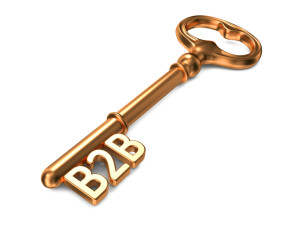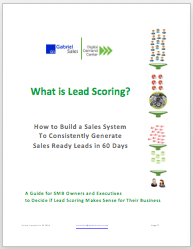
15 B2B Email Marketing Tips
15 B2B Email Marketing Tips for SMBs to Generate Demand and Real Sales Opportunities
For ten years, email has delivered the highest ROI for marketers over any other form of marketing, returning $44 for every $1 spent. A June 2016 survey of U.S. marketers conducted by the Direct Marketing Association (DMA) and Demand Metric found that email had a median ROI of 122% – more than four times higher than other marketing channels, including social media, direct mail and paid search. (Source: eMarketer, 2016)
What drives the success of email marketing?
A 2017 Marketing Sherpa report revealed, 70% of buyers prefer to learn about a new product or solution by email first, and then prefer to receive additional educational material even after being initially engaged by a business development representative.
And according to a 2016 Hubspot study, email is the third most influential source of information for B2B audiences, behind only colleague recommendations and industry-specific thought leaders.
With these eye-popping numbers, it’s no wonder 59% of B2B marketers say email is their most effective channel in terms of revenue generation.
So, what do these statistics really mean about the state of email and how it should be used?
As part of Gabriel Sales integrated B2B sales and marketing campaigns, we leverage emails at multiple stages of our clients’ sales funnel development program to generate new leads. We also use email marketing to develop buyers not yet ready to purchase, and over time, we use lead scoring tactics to identify which leads become qualified sales opportunities. Subsequently, we do a lot of research, and analyze a lot of our own data.
What the data tells us is, B2B email marketing does not always function in the same way as B2C marketing. B2C is typically focused on direct response and an immediate transaction, as opposed to generating leads and developing them over time. Thus, click-through rates (CTRs) are 47% higher for B2B email campaigns than B2C email campaigns. That being the case, B2B has a slightly different set of best practices.
So, here are our 15 B2B Email Marketing Tips that can help you with improving your B2B sales prospecting campaigns across every stage of your sales funnel development.
1. Don’t Expect Immediate Results
Emails are a great way to introduce your solution and make buyers aware you exist. They are also a great way to:
- Start a digital dialogue with the buyer
- Educate buyers about the problems you solve
- Kick off an outsourced sales lead generation campaign
- Move a buyer deeper into the sales funnel
- Build a short list of early stage buyers for buyer development reps to call
But buyers rarely buy, or immediately schedule an appointment after getting one email from you, so don’t expect overnight success. You will get some quick wins, but this will be a marathon or middle-distance race and not a sprint.
2. The Ability to Score Leads is Critical for Most B2B Companies
Most B2B companies are not straightforward transactional sales, selling concrete commodities that can be closed in one phone call. But that stated – if your sale is at a low price point and every buyer that shows interest can and should be closed, then lead scoring is not critical. What is critical: you need to call every lead as soon as they show interest, so all you need is the ability to track opens.
- However, if you are like 90% of B2B companies, with longer sales cycles and a heavy need to educate buyers to build trust, then lead scoring may be critical for you to prioritize which buyers are most likely to buy. In fact, a recent Eloqua study of 10 B2B companies using lead scoring systems showed close rates increased by 30%, company revenue increased by 18% and the revenue per deal increased by 17%. Finally, according to Aberdeen Research, companies that get lead scoring right have a 192% higher average lead qualification rate than those that do not.
FORM GOES HERE
3. Increase Your Results by Implementing the Right Marketing Automation or Email Marketing Software for Your Business
B2B companies these days are implementing marketing automation systems to communicate regularly with potential buyers for product launches, solution education, and to keep their products or services top of mind. And why not, businesses that use marketing automation to nurture prospects see a 451% increase in qualified leads. (The Annuitas Group)
So as businesses shift to automation software, it’s important to keep these statistics in mind:
- 80% of marketing automation users saw an increase in the number of leads, and 77% had an increase of conversions. –VentureBeat
- Companies using marketing automation generate twice as many leads as those using just email software. –Autopilot
- Marketing automation drives a 14.5% increase in sales productivity and a 12.2% reduction in marketing overhead. –Nucleus Research
- 78% of successful marketers say that marketing automation is most responsible for improving revenue contribution. -The Lenskold Group
4. Have a Specific Intention for Your Buyer for Every Email
In this era of content marketing and access to digital education, email is being used for multiple purposes, so it is important that each email has a specific intention. If it’s an initial email lead generation campaign, you may just want to introduce a new solution or highlight a problem you help solve to identify buyers interested in the solution or need that problem solved.
If the goal is to communicate with a buyer you have been developing for a while, and who has opened multiple emails, or has engaged with your content in the past, you may want to ask for an appointment or send them a more specific piece of content to move them deeper into the funnel.
The key is to know what your goal is for every email, and don’t try to do too much at one time in a single email.
5. Set a Business Goal for Your Company for Every Email
In this era of content marketing and access to digital education, email is being used for multiple purposes, so be sure you have a goal for each email. Is it for nurturing? Is it for generating a new lead? Or is it for developing a lead? Knowing the end goal for each message allows you to convey each message more precisely to your audience and often leads to better open rates and click-through results. As a best practice that’s produced great results for us we craft the copy of the email to the specific target audience and offer them the right educational piece according to the content framework below:
6. Use Trade Shows as an Opportunity to Generate New Sales Leads
Emails are a great way to build awareness and to fill your booth prior to a trade show. But over the past several years, we have discovered that a trade show is a great “artificial” event to also fill your database with a fresh set of leads.
The benefits of trade show audiences is three-fold: first, the average trade show attendee has travelled 400 miles, so your audience is truly national (Source: CEIR report ACRR 1153.12), second, more than 90% of trade show attendees say they are looking for new products (source: Exhibits Survey Inc.), and third, 46% of trade show attendees are in executive or upper management roles (source: CEIR).
We have had great results running campaigns to a rented, opt-in list of potential attendees – not necessarily registered attendees. Sending to this broad list of potential attendees, we have seen the following results:
- 3X to 5X the typical unique open-rates of a cold outbound email campaign – because non-attendees are still curious about what will be happening at the show and what they will be missing
- 2X to 4X the typical email click-through-rate
- Emails are often forwarded to known attendees within the company by the original recipient
- Inside reps are able to set meetings with buyers both at the show and buyers that are not even attending the show
7. Design For Mobile First
In 2017, the Apple iPhone leads email client market share with 33% of opens, so design your emails for mobile first. And over the past year, we have seen a rise in senior executives opening early sales pipeline emails on their mobile phones, so this becomes even more important. We became curious about why this was so we asked and the answer was simple: Executives tend to open these emails and check out the educational content offers when they are in between meetings, (in meetings, too, which they loathed to admit) and in the evenings at their kids extracurricular events.
8. Keep Subject Line Short
Buyers use smartphones over 60% of the time to view emails. In general, we put too much copy in the subject line, and often bury the point of the email at the end of the subject line. Our research shows, shorter subject lines are opened more often, especially when the point of the email comes first.
9. Keep Email Copy Brief and to the Point
Once again, more than 60% of buyers check email on mobile phones, so keep this top of mind when you write your copy. Your emails should be short, easy to read, and broken into paragraphs – no more than three short paragraphs is ideal. You can also use bullets to catch your buyer’s attention and highlight key points.
10. A/B Split Test Subject Lines
When we run outsourced sales lead generation campaigns, we run a series of three emails to the same list, as a best practice. We often use the same educational content offer for that three-part campaign, which allows us to perform a comprehensive A/B subject line split test as part of the first effort. We will often test as many as three to four subject lines in the first email, which allows the subsequent email blasts to drill down on the topics most likely to engage the buyer.
11. Don’t Overuse Your Company Name
Similar to your sales calls, spending too much time talking about yourself or referencing yourself does not get the most effective results. Keep your attention on the buyer, their challenges and their needs. Use your name once or twice. Don’t begin every sentence with your company. Email should not typically be an advertisement.
12. Lead with Educational Content Offers
B2B offers perform best when you offer something of value, so lead with an educational offer. Emails are the preferred way buyers wish to learn about new solutions, so attach a link to a valuable blog article, white paper or video that talks about the solution and not a product pitch. When buyers get a link with an interesting asset, they are more likely to save it and/or share it.
13. Use Customer Success Stories
At later stages of pipeline development, once a buyer has some familiarity with your solution, it will make sense to talk about yourself. When you do, use a case study as an example of a key success. This allows a buyer to understand how your solution has helped solve problems for customers like them, and helps them start to visualize and consider how your solution can help them solve a similar problem.
14. Use Your Buyers Name and Company in the Email
With the adoption of marketing automation tools, data merge fields are now the norm. It’s not acceptable not to personalize, so use the prospect’s first name in the email. You can also include the company name if it makes sense, however, only do this if you have a database you know is accurate. By doing so, your email stands out.
For most companies this is all the personalization you need. Personalizing email campaigns with different content offers, color schemes, etc. is not typically worth the effort unless you have database segments over 10,000 plus. If you do need to personalize, and deal sizes support this level of investment, it probably makes sense for your sales rep to manage this directly.
15. Always Have a Call to Action
Your email should always have a clear call to action. When we run an outsourced sales campaign, it should be as specific as possible and require the least amount of effort from your prospect. For example, briefly describe the value of the educational content and clearly display the link to it, or give them a day/time for a 10-minute call to discuss the value you can provide to their business. If you have a calendar app, such as Calendly, use it to let prospects set up their own meeting with you.
How Gabriel Sales Help?
Gabriel Sales specializes in helping B2B companies build modern sales and marketing operations.
We do this for companies with a wide variety of technology, service businesses and manufacturers that have a non-transactional solution based sales process. What this means is, to close the sale, you must build trust with the buyer, which typically requires a thought leader, consultant, sales engineer or demonstration of the product to engage the buyer and close business
Email marketing is just one piece of what we do. We can also help with strategy, automation systems implementation and other tactics required for demand generation.
Feel free to contact us to schedule some time to discuss how Gabriel Sales can help you grow your business.


 B2B lead generation is one of the top sales challenges facing many small business that want to grow their sales revenue. And generating a consistent flow of leads is critical in a competitive market. To grow the sales of a solution, establish or maintain a competitive advantage to thrive in today’s sales environment, which requires innovative approaches and hard work.
B2B lead generation is one of the top sales challenges facing many small business that want to grow their sales revenue. And generating a consistent flow of leads is critical in a competitive market. To grow the sales of a solution, establish or maintain a competitive advantage to thrive in today’s sales environment, which requires innovative approaches and hard work.